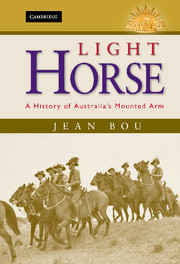Book contents
- Frontmatter
- CONTENTS
- List of maps
- ACKNOWLEDGEMENTS
- AUTHOR'S NOTE
- ABBREVIATIONS
- INTRODUCTION
- CHAPTER 1 ANCESTORS
- CHAPTER 2 TOUGH LESSONS
- CHAPTER 3 THE HUTTON ERA
- CHAPTER 4 UNFULFILLED PROMISE
- CHAPTER 5 THE LIGHT-HORSEMEN 1
- CHAPTER 6 MOUNTED RIFLES
- 7 CAVALRY
- CHAPTER 8 THE LIGHT-HORSEMEN 2
- CHAPTER 9 THE FINAL YEARS
- CONCLUSION
- EPILOGUE
- APPENDIX THE ‘BEERSHEBA CHARGE PHOTO’
- Notes
- BIBLIOGRAPHY
- INDEX
7 - CAVALRY
The light horse at war, 1917–19
Published online by Cambridge University Press: 05 July 2014
- Frontmatter
- CONTENTS
- List of maps
- ACKNOWLEDGEMENTS
- AUTHOR'S NOTE
- ABBREVIATIONS
- INTRODUCTION
- CHAPTER 1 ANCESTORS
- CHAPTER 2 TOUGH LESSONS
- CHAPTER 3 THE HUTTON ERA
- CHAPTER 4 UNFULFILLED PROMISE
- CHAPTER 5 THE LIGHT-HORSEMEN 1
- CHAPTER 6 MOUNTED RIFLES
- 7 CAVALRY
- CHAPTER 8 THE LIGHT-HORSEMEN 2
- CHAPTER 9 THE FINAL YEARS
- CONCLUSION
- EPILOGUE
- APPENDIX THE ‘BEERSHEBA CHARGE PHOTO’
- Notes
- BIBLIOGRAPHY
- INDEX
Summary
The light horse had played a prominent role in the advance across the Sinai and, although the infantry and other arms had become more important from First Gaza onwards, it was still an important part of the Egyptian Expeditionary Force (EEF). So far the employment of the light horse had roughly conformed to pre-war notions of how dominion mounted troops might be used. Organised as mounted rifles, the light horse's employment was based on mobility and rifle firepower. Mobility had been proven in the ability of the mounted troops to get at the enemy across tracts of desert, but rifle firepower, despite successes on the day, had been proven to have limitations. Sending mounted troops alone against prepared defences was risky business. With changes to the EEF's structure in 1917, however, as well as learning how to employ mounted troops, through 1917–18 the light horse would, with some exceptions, be better and more properly exploited as a mobile arm of an all-arms army. This development would also lead to a significant change to the light horse's form, and by the end of the war most of the light horse had undergone a conversion from mounted riflemen to full cavalry.
Following the failure at the second battle of Gaza the EEF underwent a dramatic overhaul. General Sir Archibald Murray's command had maintained control in Egypt (which was a paramount requirement), secured the Sinai and extended the essential logistic arrangements to the Palestine frontier, but his inability to grapple with the requirements of fighting his army there had been manifest. The morale of the EEF had ebbed, and London had lost confidence in him. The despatch of General Sir Edmund Allenby to replace him at the end of June 1917 marked a change in the EEF's fortunes. Partly this was owing to the effect of Allenby's arrival, which, as much through his frontline tours and changes to command arrangements as anything, gave the men of the EEF an impression of confidence and competence – a contrast to the general impression held of Murray.
- Type
- Chapter
- Information
- Light HorseA History of Australia's Mounted Arm, pp. 170 - 203Publisher: Cambridge University PressPrint publication year: 2009

